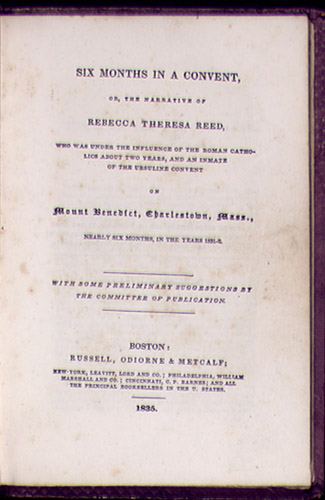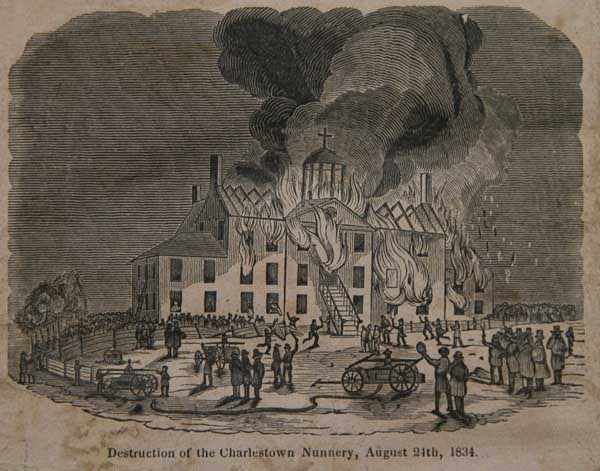Rebecca Reed and the Ursuline Convent
By Mark Hurwitz
Rebecca Theresa Reed was born in 1813 in Charlestown, Massachusetts. She was raised Protestant and attended Christ Church in the City of Boston (Old North Church) with her family in the early 19th century. Although the Reed pew records can’t be located, city records indicate that Rev. William Croswell (vicar 1829-1841) acknowledges her as a member of his congregation in the 1830s. Reed’s and Croswell’s fates would be tied in print due to media coverage of the Ursuline Convent arson trial.
In 1832 at the age of 21, she informed her family of her decision to attend the Ursuline Convent in Charlestown to study to be a nun. As the Catholic population began to grow in Massachusetts, its religious leaders began the process of establishing a convent and school. The Ursuline community’s principal mission was to administer a boarding school for girls aged six to fourteen. The school began to enroll primarily the daughters of wealthy Protestants and Unitarians. Of the 47 girls who attended in 1834, only six were Catholic.
The Ursuline Convent was the idea of Rev. John Thayer, a Protestant who converted to Catholicism and served as a priest in Boston in the late 18th century. He spent several years in Ireland raising the necessary funds to construct the Convent. However, it did not become a reality until 1817, when the Rev. John Lefebvre de Cheverus, Bishop of Boston, got involved. The Ursuline Convent first opened in 1826 in the city of Boston. Two years later, the convent and school moved to a section of Charlestown that is now located in Somerville.

Reed’s experience at the school lasted just under six months. Three years later she published a book entitled Six months in a convent or, the narrative of Rebecca Reed who was under the influence of the Roman Catholics about two years and an inmate of the Ursuline Convent for nearly six months. It focused on the harsh treatment she felt she and others received at the convent. In her book she also claimed that the priests and nuns were planning on kidnapping her and whisking her off to a convent in Quebec. After she escaped the convent, Rev. Croswell welcomed her back to Old North Church, where she attended weekly services until she died from tuberculosis at the young age of 26 in 1839.
In July of 1834 after Reed had already left, Sister Mary John fled from the Ursuline Convent after having a mental breakdown. Fearing a scandal, Catholic Bishop Benedict Fenwick persuaded the woman to return with him to the convent. Rumors quickly spread throughout Boston that Fenwick had forced her to return, and the Ursuline nuns were now holding her against her will and torturing her in the convent’s secret dungeons.
Maintaining that Sister Mary was mentally ill, the Mother Superior denied outsiders from seeing her. By August, two members of the Charlestown Selectman showed up and insisted that they be allowed to enter the grounds to speak with the nun and to see the dungeon. The Mother Superior at first refused their request and threatened the selectmen saying, “If you refuse to leave, the Bishop will bring 20,000 Irishmen to pull your houses down over your heads.”
A few days later, the Mother Superior finally agreed to let the Selectman onto the property. After speaking with the nun and being assured by her that Sister Mary wasn’t be held against her will, and finding no trace of any dungeons, they left and promised to inform the public of their findings. Unfortunately, that same night, a group of men arrived in the Ursuline Convent and demanded the release of the nun. When their demands were not met, they looted and burned the convent and school to the ground. During the attack, several fire brigades arrived but chose to stand by and simply watch.

The following day, city officials met and after a short investigation, several of the men involved were arrested and charged with destruction of private property, arson, and looting. The trial began in December of 1834. Of the thirteen men who were charged, twelve of them were acquitted of all charges. The thirteenth was convicted and sentenced to life imprisonment. He was later pardoned by the Governor and released.
During the years that Rebecca Reed attended Christ Church, she had a developed a close relationship with Rev. William Croswell. She considered him to be her good friend and spiritual advisor, and she later claimed during the trial that it was Croswell’s idea for her to enter the convent. Reed described herself as Catholic Episcopalian, a designation that was publicly ridiculed and misrepresented by the judge as Catholic-Protestant. Considering Rebecca Reed’s spiritual advisor’s own tendencies toward high church practices, Reed’s description was probably an accurate one.
Rebecca Reed’s friendship with Rev. Croswell was mentioned in a Maryland newspaper editorial published shortly after the trial. The newspaper editor referred to Rebecca Reed as:
a wretched, illiterate woman of no character to whom from pure motives of charity, the Mother Superior afforded asylum, has become the tool and dupe of an ignorant fanatic person of the name of Rev. Croswell who rants and roars in his church every Sunday and at his instigation obtruded on the public attention, an infamous and libelous book, titled “Six months in a Convent.” The vulgarity of Croswell’s style of diction, for that despicable fanatic is the real author of the vile work, is only surpassed by his incredible and wicked falsehoods.
The editorial ended by stating that the newspaper would expose:
the clumsy and calumnious fiction, of which the continent Rev. Croswell has become the father by the woman, Rebecca Reed, whom the Mother Superior, from an impulse of benevolence, snatched from poverty. Every person of knowledge and mind, who has read the disgusting book, declares that it is a tissue of the rudest ignorance and the vilest falsehood, such indeed, as might have been expected from such a literary platonic pair of lovers, as the ingrate woman Reed, and the psalm ranting parson Croswell.
A Boston newspaper responded by defending Rev. Croswell’s character stating, “There is no minister in our community more highly and deservedly respected by all denominations of Christians than Rev. Croswell, and this libel upon his character is more vile and atrocious than an assault upon a clerical gentleman we have ever had occasion to notice.”
The editor of the Boston Traveler suspected that the Maryland paper made these accusations against Rebecca Reed and Rev. Croswell because Croswell defended Rebecca Reed’s character during the trial when people testified that Reed had spread rumors about the mistreatment of nuns at the convent. Croswell affirmed, “I hereby certify that Miss Reed has been for more than two years, a communicant at Christ Church: that I have always regarded her as a devout person and exemplary in her Christian walk and conversation; that I repose great confidence in her sincerity and intention to relate, on all occasions, what she believes to be the truth.”
After the fire, the Ursuline nuns attempted to continue their work in Roxbury, Massachusetts. Once again they were harassed and driven from the city. As a result, the nuns decided to return to Quebec. In 1838, an attempt was made to restore the Ursuline community in Boston, but there was no interest by the nuns. Two years later, their Bostonian ministry was disbanded.
